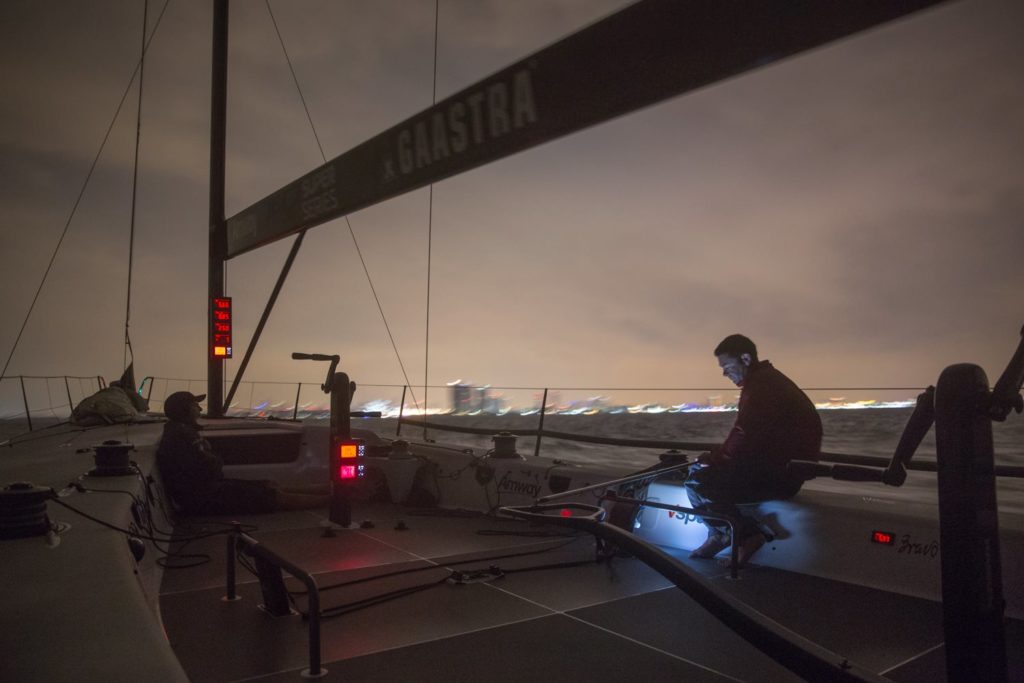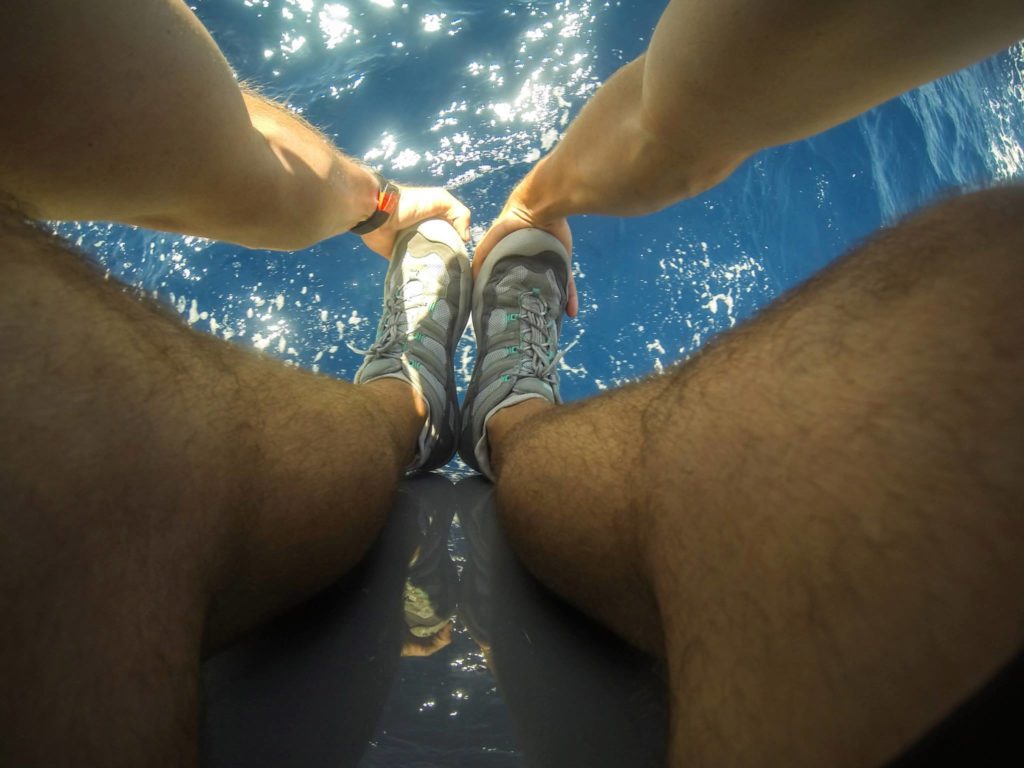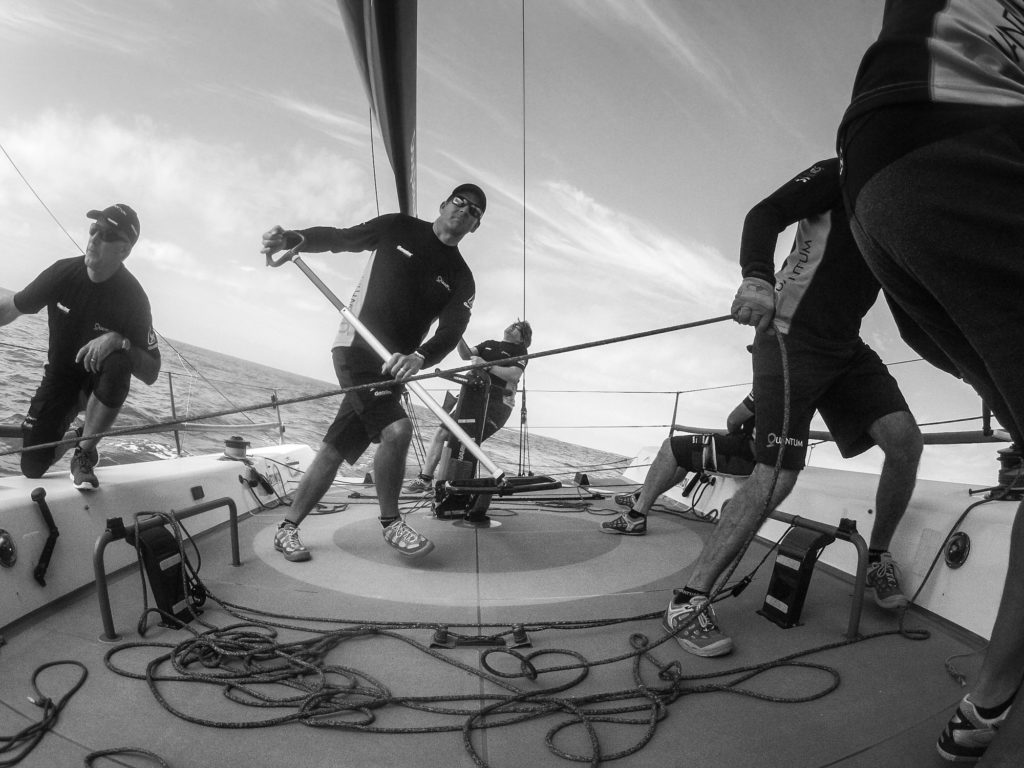It’s a Friday afternoon in Miami in late February, and Keith Brash talks on his phone as he leans against a stainless steel counter in a 40-foot shipping container temporarily deposited in the parking lot behind Monty’s on South Beach. While the shore team of Quantum Racing’s TP52 is ticking off boxes on its work list, so too is Brash. He’s scheming his next hit, contemplating how he’s going to capture the day’s practice session in some new and clever way. He has an arsenal at his disposal: multiple cameras, both still and video, an array of lenses, housings, drones, and dozens of rechargeable batteries. “My life is like being a mercenary, a gun for hire,” says Brash, a South African native who’s on his seventh tour with Quantum Racing as its media producer. “I go where the show goes.” On this day, the “show” is the Miami stop on the TP52 Super Series where we caught up with grand-prix sailing’s most creative crewmember, whose job description is to simply make the sport, and the sailors, look awesome.
How did you end up being a full-time producer for a race team?
My background was in photography and film, mainly producing behind-the-scenes stuff in Cape Town. In 2008, when Quantum put the TP52 program together, they wanted to show the world that they were capable of competing at the highest level. They wanted to make as big of a statement as they could, which meant showing the sailors behind the scenes and onboard, and doing so in innovative ways. We started with the concept of Quantum TV, which remains today, and created a YouTube channel. It snowballed from there. The whole sailing thing was a new industry to me, but I got connected through a friend. In fact, I’m not a sailor, and even though I’ve spent so much time on the boat, I still wouldn’t consider myself one.
Pro sailors typically disdain cameras on the boat, especially during racing; how were you initially received?
For the first three months or so it was difficult. The whole thing for me was to not disrupt the team in any way, and kind of be invisible. As the years have gone, on it’s gotten easier. The guys are always willing to talk about the racing and wear cameras because we all knew what the objectives are. The GoPro really came in to use in 2009, and that was the game changer, to get onboard stuff when we couldn’t be there. You’re one of the few guys currently making a living as a dedicated media guy, outside the America’s Cup or Volvo; is there a future in it for anyone? I’ve remained with Quantum Racing because there’s a lot of loyalty. They really look after me. I focus all my energy in this 365-day job. I can’t stop working. I don’t work exclusively for them though. I’ve done the ISAF Youth Worlds, the Volvo Ocean Race, a stint with Artemis Racing, and now doing some stuff for Nautor’s Swan. I also have clients in Cape Town that I work with when I’m home, but basically it’s life on the road for Quantum.
What is life on the road?
Basically I leave Cape Town in April, and the end of the [TP52] season is October, so outside of those months I’m in Cape Town to recuperate and work on highlight content. During the racing season I take the pictures and video, edit, and also manage all the team’s social media. With all these types of things you have to concentrate, especially with social media. I’m never far away from doing another post and trying another idea. There’s so much footage created during an event that the challenge is to get stuff out while you can. It is full on during the event, with late nights and early starts. The stuff I don’t get to on site I’ll edit between events. I’m sort of a mobile editing suite. I take all my hard drives with me, and wherever I end up I’m working, whether that’s Thailand, Hawaii, Africa, China, or India. I’ve actually lost track of where I’ve been. My thing is I love what I do. It’s not work. It’s hard fun.
You were an early adopter of using drones to capture race footage; is that the next game changer?
The drone thing has gotten to me now. I really like it. The first drone video I saw was a snowboarding one, and I thought right away that the perspective would be different. I don’t think it will replace helicopters, though. My whole philosophy is to innovate, and this gave me a new perspective on the racing. So I bought one, the basic model, I crashed it—and crashed it again—and just progressed from there. I then bought a quad-copter drone, which is a four-bladed model. I currently own about four drones, including a six-blade one.
With so many tools and cameras to use, how do you approach each race day?
We’ll brainstorm a couple of ideas, but to be honest, there’s no shortage of content to get out, and it’s not scripted at all. It is a bit by the seat of the pants. We have fixed cameras onboard the raceboat and cameras on the coach boat [for coaching purposes]. To actually get the footage and compile it for the guys before dinner every night can be a mission. If there’s been an incident we’ll review [the footage], but it’s only when the guys ask me specifically for something they can look at. But I don’t make special highlights to give them each day.
What’s in your hard case today?
I have four GoPro Hero 3+ units with all the various attachments. The biggest consumerable there are the anti-fog inserts. I go through them like they’re going out of fashion. Then there’s the Canon 6D camera and a wide range of lenses. I’ll shoot video on the SLR, and I have two Sony units; one is an EX1 [a high-definition camcorder] and the other a small handheld camera. I use an extendable pole quite a lot with the GoPro. My main drone is the stock DJI Phantom2. I’ve tried a few others, but this quad is quite maneuverable, which is important for landing on the chase boat—it requires essentially catching it mid-air. It doesn’t have redundancy, so if you lose one motor that’s it—it’s in the drink. On the drone I use a two-axis video Zenmuse Gimble, model H3-2D, which the GoPro mounts to. The latest addition is a video transmitter and goggles from Fat Shark, which allows me to see what the GoPro is seeing. It’s a trip. I started flying without goggles, and initially shot still photos by setting the GoPro on time lapse [it takes an image automatically every second, or whatever time interval you choose]. I knew I needed to learn to fly the Phantom before I got fancy with video.
I can only imagine your daily battery-charging routine.
It’s Armageddon. I have so much on my mind in the morning, so I have to approach it like and astronaut before liftoff—basically working off a mental checklist. I skateboard to the race village every day because those fifteen minutes of freedom clear my mind of everything. It’s quite overwhelming at times. When I get to the boat in the morning I’ll do camera placements, and I have interviews to do. I will leave the race village as soon as I finish my stuff. I do no socializing—I won’t even have one beer. I go straight to the hotel, plug everything in, start the charging and the importing, and rarely get to sleep before one, two, or even three in the morning. I feel like I’ve trained for it, though—it’s what I’ve come to do. I’ll find the energy somehow.
Will we someday see a bevy of drones flying over starting lines and marks?
I’m not sure. The whole drone industry is in its infancy. If you fly below 400 feet and it’s not commercial work, you’re safe. That’s the golden rule. For us it’s not commercial, it’s entertainment. The reason why more guys are not doing it is because it’s very risky. There are waterproof drones available now, but they’re very expensive. I’ve been flying every single day for six months. I’ve crashed and rebuilt them, and I’ve taught myself to repair the microelectronics. It’s not as easy as it looks; the basic flying is easy, but once you start doing maneuvers you’re going to crash. In fact, if you’re serious about it, buy two because you’ll eventually destroy one no matter how good you are. Also, right now it’s sort of a grey area on the racecourse. For example, how close you get to the boats is still a question. The closer I get the better the footage, but I don’t want to tear a kite and impede racing, so I’m very cautious with it. I’d also add that 20 minutes is the longest flight time you can get now, so you have to know what you want before you send it up. The secret is having a flight plan.

Keith Brash, Drone Take Off




















